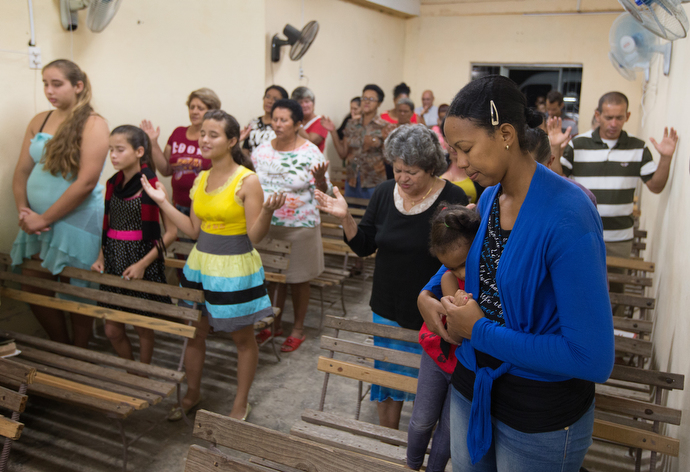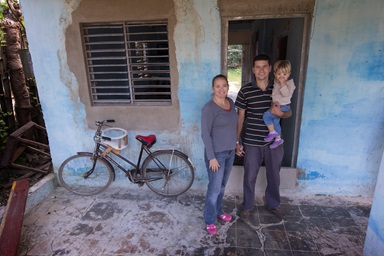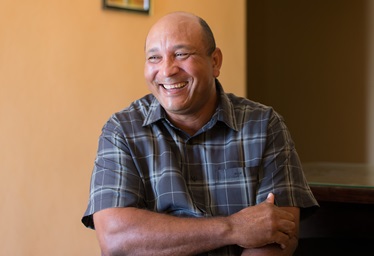The long narrow room in a hardscrabble neighborhood of Santa Clara, about 230 miles south of Havana, still resembles the auto repair shop it once was more than the church it has become.
Still, there are thoughtful touches at the church — optimistically named A Place of Hope. A line of wall-mounted fans sit ready to cool those seated on the wooden benches and a projector and screen above the altar in the rear assist with communal singing.
As people from the neighborhood slowly fill the pews on this Wednesday night, pressing cheeks together in greeting, the atmosphere in the room starts to change. The pastor’s wife fervently leads praise songs, a little girl offers an interpretive dance in the center aisle and the call to prayer becomes increasingly urgent.
“God knows your worries. God knows your weakness,” says Leandro Cordero, the pastor, telling the parishioners they must “surrender to his arms.” His sermon focuses on putting God first and accepting divine help.

Parishioners stand to pray during worship at A Place of Hope Methodist Church, a converted auto repair shop, in Santa Clara. Photo by Mike DuBose, UMNS.
Cordero and his wife, Yenisel Ramos, have spent more than two years here, building attendance at Sunday service from 15 to more than 70. “This is a difficult place,” he admits. “There are a lot of people who worship idols.”
An upcoming evangelism campaign will give church members an opportunity to learn how to draw others to the faith. “We are going to share invitations and treats for the campaign.”
Making a joyous noise in Havana
At the other end of the Methodist spectrum, Ingelsia Metodista de Marianao is a long-established presence in Havana and the pastoral home of Bishop Ricardo Pereira.
The church’s white and gold color scheme is reflected in the walls, drapes and the artificial flowers decorating the sanctuary. All the windows are open during this second Sunday service so parishioners can enjoy the mild November breeze.

The Marianao Methodist Church is a long-established presence in Havana and the pastoral home of Bishop Ricardo Pereira. Photo by Mike DuBose, UMNS.
Young musicians on drums, guitars and keyboards open the service, accompanying a young male vocalist and four back-up singers. Between songs, announcements of birthdays and anniversaries are made, fabric bags passed for offerings and several children come to the front to be blessed by the bishop.
By the third praise song, which features a trumpet player, a group of young people have started a line dance in front of the communion rail. They hop up and down with enthusiasm during the next song and then, after the bishop asks for one more, young men dance into a frenzy as if they were cheering their favorite team at a soccer match.
Singing the spirit in Cuba
Special report on the Methodist Church in Cuba.

The worship leader, Rosmery Díaz, follows with an original song and then the bishop walks down the center aisle, calling upon the power of God. Some worshippers have their phones out to take a photo or video as he places a hand on people as he passes.
“In the depths of our heart, there is a song to the Lord,” Pereira says. “It’s not about pleasant melodies. It’s about a heart that is humble before the Lord.”
Members like Reinier Charón, 31, are firm believers. A Christian for 13 years, he says he used voodoo dolls as a treatment for sickness in his previous religion. Then he saw a film about Jesus on television and heard a preacher talk about the sacrifice of Christ.
Soon after, he and his mother went with a Christian neighbor to church. “From that moment, we continue in Christ’s way,” he says. “My passion is Christ.”
His involvement in many activities of the Marianao congregation and with the larger church point to the emphasis by Cuban Methodists on fellowship with brothers and sisters in the faith to help achieve growth in Christian life.
Training church leaders
For many years, Methodist pastors got their training at the evangelical seminary in Matanzas. But the increased demand for pastoral leadership led the church to open its own program, says the Rev. Enoel Gutiérrez. He is principal of Seminario Evangélico Metodista, which opened in central Havana in 2006 after U.S. volunteer teams helped renovate the building.

Bishop Ricardo Pereira lays hands on parishioners during worship at Marianao Methodist Church. Photo by Mike DuBose, UMNS.
The seminary now receives 40 new pastors annually, who come twice a year, over a four-year period, for a 21-day residential course. That means the 15 professors teach four groups of 40 students each year.
Academically, the route to this institution includes completing the 12th grade, studying for three years at an extension seminary and accruing two to four years of pastoral experience. Currently, the seminary also has four students pursuing a master’s degree. Three professors have finished their doctorates.
The vision of the seminary is the formation of better pastors, not academics, says the Rev. Alfredo González, academic dean. “For this reason, we put an emphasis on practical theology.”
Tuition is free. The national church pays 20 percent of the cost, with the remainder coming from donations, mainly from the U.S. and England. Among its official relationships is one with Ashland Seminary in Ohio.

Parishioners sing during Sunday worship at Marianao Methodist Church. Photo by Mike DuBose, UMNS.
On a November Monday morning, 30-plus students, including three women, are studying Greek in one of the classrooms. A video screen above a whiteboard displays the day’s lesson. A few students are using laptops and tablets as the professor lectures, but most are taking notes by hand and looking at lessons on paper.
In the kitchen, a huge pressure cooker is filled with beans, rice and chicken. Lunch that day also will include cucumber salad and sweet potato. The main dormitory holds rows of bunk beds and cupboards for clothes and other personal items.
Going digital at Havana seminary

In some respects, those attending are Seminario Evangélico Metodista are ahead of many Cubans in terms of using digital technology.
In the library, librarians from different seminaries in Havana are singing during a morning devotional period. They meet annually for training led by a woman from Argentina.
On the wall of the principal’s office is a painting of John Wesley on horseback in Cuba. The founder of Methodism never visited the island but the artist drew inspiration from a different portrait of Wesley and substituted a Cuban landscape. The idea was to show that the Wesleyan movement “has good roots in Cuba,” Gutiérrez says.
In another section of Havana, work continues on six two- and three-bedroom houses for seminary professors. Volunteer teams come to assist the five workers on the project.
The speed of the construction, which started in January 2012, depends on funding and availability of materials, says José Remón Ochoa, construction chief. Four of the one-story houses are finished, except for the plumbing.
Seminary on a local level
On Monday nights, the Marianao church runs the largest of the 34 local extension seminaries around Cuba, with 389 students. In total, the extensions have 1,702 students, 1,800 graduates and 324 professors.
Rigoberto Figueroa, a former Roman Catholic and vice rector of the national Methodist seminary, oversees the Marianao school. About 230 adults are baptized each year in this congregation and the basic course of ministry offered by the extension “helps them discover their gifts,” he says.

Students take notes during class at Cuba's Evangelical Methodist Seminary in Havana. Photo by Mike DuBose, UMNS.
Some opt to continue their studies. “We believe your calling is a responsibility between the person and God,” Figueroa adds. “The seminary cooperates with the preparation for that calling.”
The seminary classes and other congregational activities also reflect the natural sociability of the Cuban people. “The testimony of the church, the community that you find there, has been one of the means that God has used … to take us to Christ, to lead us,” Figueroa says.
Bloom is a United Methodist News Service multimedia reporter based in New York. She and UMNS Photographer Mike DuBose visited Cuba in November. Follow her at https://twitter.com/umcscribe or contact her at 615-742-5470 or [email protected]
Like what you're reading and want to see more? Sign up for our free daily and weekly digests of important news and events in the life of The United Methodist Church. Subscribe to e-newsletter.
Like what you're reading? Support the ministry of UM News! Your support ensures the latest denominational news, dynamic stories and informative articles will continue to connect our global community. Make a tax-deductible donation at ResourceUMC.org/GiveUMCom.




